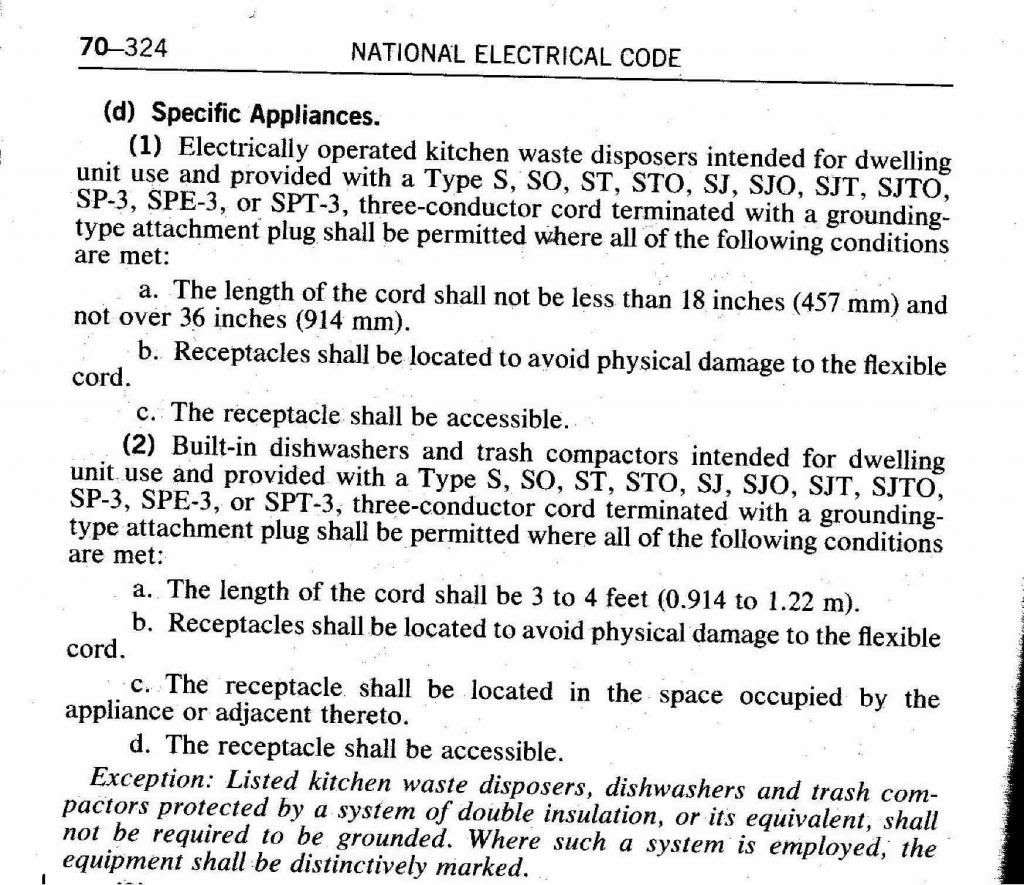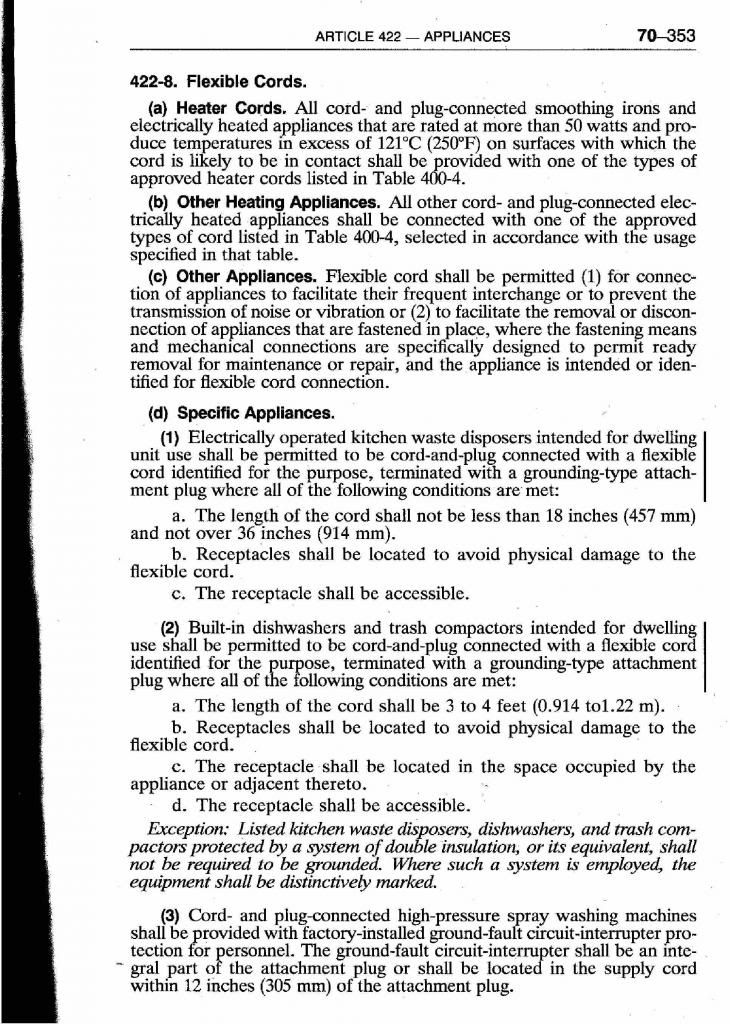- Location
- Placerville, CA, USA
- Occupation
- Retired PV System Designer
The Kenmore quote was for a garbage disposal (the topic of the post it replied to), so there may or may not be similar wording for Kenmore dishwashers....(except Kenmore).
The Kenmore quote was for a garbage disposal (the topic of the post it replied to), so there may or may not be similar wording for Kenmore dishwashers....(except Kenmore).
Good idea, based on the information in this thread it's not very likely that a dishwasher with a cord and plug can comply to the exact letter of the code (except Kenmore). My last experience with installing a receptacle for a cord and plug connected dishwasher went the way of this thread. In the end an appliance cord from home depot was used. :ashamed1:
And what was listing instructions for the cord you used?
This is starting to smell a little like the classified breaker issues.
InSinkErator cord kit for disposal http://www.insinkerator.com/en-us/H...e-Disposers/Evolution/Pages/PowerCordKit.aspx Whirlpool cord kit for dishwasher http://www.lowes.com/pd_172498-46-4...RL=?Ns=p_product_qty_sales_dollar|1&facetInfo= GE cord kit for dishwasher http://www.homedepot.com/p/GE-6-ft-...14664?keyword=ge+dishwasher+cord#.UbvAECDD_mI
Thanks drspec.InSinkErator cord kit for disposal http://www.insinkerator.com/en-us/H...e-Disposers/Evolution/Pages/PowerCordKit.aspx Whirlpool cord kit for dishwasher http://www.lowes.com/pd_172498-46-4...RL=?Ns=p_product_qty_sales_dollar|1&facetInfo= GE cord kit for dishwasher http://www.homedepot.com/p/GE-6-ft-...14664?keyword=ge+dishwasher+cord#.UbvAECDD_mI
InSinkErator cord kit for disposal http://www.insinkerator.com/en-us/H...e-Disposers/Evolution/Pages/PowerCordKit.aspx Whirlpool cord kit for dishwasher http://www.lowes.com/pd_172498-46-4...RL=?Ns=p_product_qty_sales_dollar|1&facetInfo= GE cord kit for dishwasher http://www.homedepot.com/p/GE-6-ft-...14664?keyword=ge+dishwasher+cord#.UbvAECDD_mI
I use the InSinkErator cord kit for all brands of disposal and the GE cord kit for all brands of dishwashers. I normally get them at Home Depot. $11.99 for the InSinkErator cord kit and $9.97 for the GE cord kit. (I just got several of these for $4.88 each) Never had a problem with any inspectors, but as far as it technically being in violation of NEC, probably.I noticed on the page for the whirlpool there was a "customers also viewed" category near bottom of page. This may very well have different items displayed for others but I had a similar cord for GE dishwashers displayed there. Looked to be nearly identical specification wise but was $20.00 higher price.
Are you in violation of NEC if you do not use the wire connectors in the kit, or even the cord connector in the kit(basically an NM cable connector)? :ashamed:
Thanks for the links. The problem I see with this is that when the plumber goes into his supply house and picks up the disposal unit, if the cord set is a separate purchase - he never buys it. When the HO purchases the DW from an appliance dealer and the cord set is a separate purchase - it's never included in the sale. At this point, is the onus on us as EC's to research and purchase the correct cord or do we hold up the job because the plumber and the HO did not supply the cords ?InSinkErator cord kit for disposal http://www.insinkerator.com/en-us/H...e-Disposers/Evolution/Pages/PowerCordKit.aspx Whirlpool cord kit for dishwasher http://www.lowes.com/pd_172498-46-4...RL=?Ns=p_product_qty_sales_dollar|1&facetInfo= GE cord kit for dishwasher http://www.homedepot.com/p/GE-6-ft-...14664?keyword=ge+dishwasher+cord#.UbvAECDD_mI
Thanks for the links. The problem I see with this is that when the plumber goes into his supply house and picks up the disposal unit, if the cord set is a separate purchase - he never buys it. When the HO purchases the DW from an appliance dealer and the cord set is a separate purchase - it's never included in the sale. At this point, is the onus on us as EC's to research and purchase the correct cord or do we hold up the job because the plumber and the HO did not supply the cords ?


I could have sworn there was a code, or maybe there should be. As far as circuits, I have always ran a dedicated circuit for each appliance. I thought that was code. In the cab. under the sink there should be a dbl. gang ring with two single 15amp receptacles. Each on its own strap, my understanding is that 9 out of 10 times you run a branch circ. to the box. Instead of having 240v on one strap, you have to install two singles. I cant find this code, but every inspector agrees.
After that, I really don't know if you are in agreement or disagreement with anything said in this thread.Kwired,that is some wonderful research.
I guess if you have a 1987 dishwasher you can make your own cord.
If you have a 1993 dishwasher, good luck finding a length of SO cord that's specifically identified for "dishwasher' use. I'd love to see the reasoning, and identify the source of that change.
I've dealt with uncounted dishwashers and disposals, using the off-the-shelf 6-ft. pigtails from the bin at the parts house. OK, so I'm an outlaw. We can discuss my reasons on another thread. PM me if you want me to start it.
Nor, apart from an exercise in apprentice class, have I ever paid the slightest heed to load calculations for putting the dishwasher and disposal on the same circuit. Not even when the circuit serves other receptacles. I can't remember the last time I actually looked at the nameplate of either appliance.
As an excuse, I'll point out that often neither appliance is present at the time the circuit is run.
The OP is asking about a need for a separate circuit for each of these appliances. Lovely. I can only see that as a 'deduced' requirement, from calculating the loads of the appliances.
Gee, and here comes 2014, with a requirement that these appliances be protected by both GFCI and AFCI's. I can hardly wait.
Why would those items require additional branch circuits? The load of these items is likely next to nothing when it comes to branch circuit load calculations.New kitchen sensor faucets (Moen, Delta, Kohler) are a reason to include two BC's under the sink. More builders are providing the electronic amenity as an attractive sales option. There is also a shower electronic valve control in the bathroom that is a little more of a fancy reach but that setup requires a GFCI interface with a cord cap in an accessible panel behind the wall.
